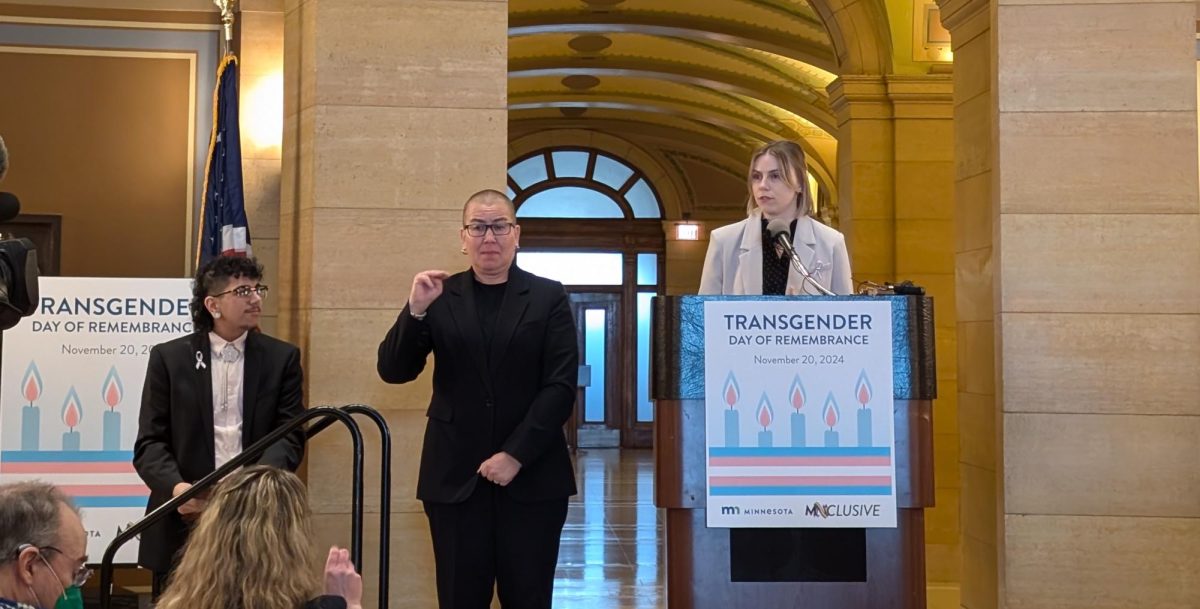The 10th annual Memorial March for Missing and Murdered Indigenous Women and Relatives gathered in Minneapolis on Friday to shine a light on a systemic disparity.
The march began around 10:30 a.m. at the newly renovated Minneapolis American Indian Center (MAIC). Information booths from various community organizations gathered in the MAIC’s Niibi Hall, while others congregated in the Frances Fairbanks Memorial Gymnasium to hear families affected by the MMIR epidemic share their stories.
“We need to bring her home,” Kathy Mishow, whose daughter Kateri went missing 18 years ago, said. “I believe in her. Eventually we’ll have some answers I hope. Somebody out there knows what happened to Kateri.”
Mishow shared stories of her daughter, who graduated from the Minnesota Transition Charter School in Minneapolis and was a member of a bowling team. Mishow told the crowd about the night she and her husband knew something was wrong and the weeks that followed.
Mishow said they had thought Kateri was outside hanging out with friends, but after multiple calls with no answers, Mishow and her husband found Kateri’s friends knocking on their door.
“Weeks went by before she was put on the missing list,” Mishow said, weeping. “I got a call from a friend of Kateri’s in jail who said he had heard people talking. He told me, ‘She’s not missing. She’s in the river.’”
No search was performed, and Kateri is still an open missing persons case in Minnesota.
The next to speak was Teddi Wind, the mother of Nevaeh Kingbird, a 15-year-old girl enrolled in the Red Lake Band of Ojibwe who went missing on Oct. 22, 2021.
“She would’ve been a senior this year, so dealing with her not being able to graduate high school is really really hard for me, her not being able to go to prom is really really hard for me,” Wind said.
Among the speakers were Sen. Mary Kunesh and Lt. Gov. Peggy Flanagan. Kunesh is a descendant of the Standing Rock Indian Reservation and Flanagan is a descendant of the White Earth Band of Ojibwe.
Flanagan took the stage holding a framed piece of paper, which she announced to be a proclamation declaring Feb. 14, 2025 as Missing and Murdered Indigenous Relatives Day in the State of Mni Sóta Makoce.
“Chi-miigwetch to everything that you will do to ensure that we remain strong, that we are here together, that we heal collectively, and that one day we will no longer face violence in our community of any kind,” Flanagan said to the crowd. “Because that future is waiting for all of us.”
Marchers took to the streets around noon, standing outside of MAIC shouting the names of lost relatives.
“Nevaeh Kingbird! Say their name! Allison Lussier! Say their name! Jeremy Jourdain! Say their name! JoJo Boswell! Say their name,” marchers chanted an ongoing list of names, a majority of those who went missing in Minnesota.
Ashley Buckanaga, 19, was among the marchers. Buckanaga was holding a glittery rainbow sign that read, “Justice for Allison n Ari.”
“My sister passed away in 2020. She was murdered. She got shot,” Buckanaga said. “She was basically at the wrong place at the wrong time. They still haven’t discovered her murderer, they’re really not doing nothing about it. She was Native.”
Marching alongside Buckanaga, her family held a banner displaying the face of Buckanaga’s aunt, 47-year-old Allison Lussier, and text saying, “Justice for Allison.”
Lussier was allegedly killed by her boyfriend in February 2024. Police received numerous calls from Lussier regarding her boyfriend’s abusive behavior, and her last report was filed days before her death in mid-February 2024, according to MPR News.
“They’re trying to put it as an overdose, which it was not an overdose, her autopsy said she had multiple brain injuries but they’re basically trying to waive it off,” Buckanaga said.
Indigenous women and girls make up around 1% percent of Minnesota’s population, according to the Minnesota Department of Safety. From 2010 through 2018, 8% percent of all murdered women in Minnesota were Indigenous.
Marcher Lucia Zaragoza, 18, said growing up as a Native woman has exposed her to the idea that as Native people, one must always be cautious of where they are and what they are doing. She also expressed frustration against authorities due to their reinforcement of historical traumas.
“We’ve already been through this before, there’s no reason we should go through it again,” Zaragoza said. “Colonization created genocide that we were put through, the camps our people were put into and exploited within, breaking treaties and placing us on land that wasn’t good for us and now setting us back to that time.”
Other community members are advocating for surrounding issues that play into the MMIR epidemic homelessness, substance and alcohol abuse, mental health and cultural exposure.
The FBI identified the Twin Cities as one of 13 U.S. cities with a particularly high incidence rate of child prostitution, and in 2015, Minnesota had the third-highest number of human trafficking cases, according to the Minnesota Department of Transportation.
“As long as our women are standing, our people are strong,” Flanagan said.















KG
Feb 20, 2025 at 9:34 am
The American Indian tragedy and the abiding pain that cries out as loved ones are remembered certainly touches anyone reading these stories. We must also ask ourselves how we, as a free and democratic society, can remain so callous to the plight of the American Indian community and allow these things to occur year after year.
As I read the experiences of these American Indian families, I also cannot help but to reflect on the hundreds of people that were killed and kidnapped from Israel on October 7, 2023. These people were of many nationalities and ethnicities: Jews, Arabs, Hindus, Israelis, Americans, Thai, Germans and many more. Today, February 20, the dead bodies of a Jewish family–Shiri Bibas and her two small children–are being returned to Israel from Gaza. There are videos of the Bibas family being kidnapped alive on October 7. As human beings, one to another, I am sure that the American Indian community can empathize with this Israeli family, as we empathize with your suffering.
Unfortunately, UMN American Indian Studies has somehow come to the curious conclusion that Jews, who have continuously lived in the land of Israel, are imperialists in their own land. This is almost incomprehensible! A wealth of documentary and archeological evidence proves that Jews continuously lived in Israel for thousands of years—in every period and in every century. But some members of the American Indian community, especially the entire UMN American Indian Studies department, have chosen to demonstrate against Israel as committing genocide, even though it was Israel that was attacked by Hamas terrorists on October 7, 2023 and it was Israelis that were massacred. The atrocities committed by Hamas were so great—mass rape and burning people in their homes—that it took forensic experts months of work on miniscule human remains sifted from the destruction—to identify some of the dead. Others may never be positively identified.
You should know that some indigenous peoples believe that it is the Jews that are the indigenous people of Israel and the Arabs—Palestinians are ethnic Arabs—are the imperialists. Harvey Yesno, a Grand Chief of the Ojibwa tribe from Thunder Bay, northwestern Ontario, recently visited Israel and declared, “We believe that Israel is indigenous to this land. History proves it. Archeology proves it.”
I urge the American Indian Studies department to rescind its December 28, 2023, “Statement on Palestine, Genocide, and Repression.” The issues dividing the Israelis and Palestinians are complex and have been festering for decades. Great minds and well-meaning politicians have devoted great effort to solving the dilemma but without success. To understand what’s involved in all its nuances requires great expertise. Please, let the parties concerned work it out for themselves.